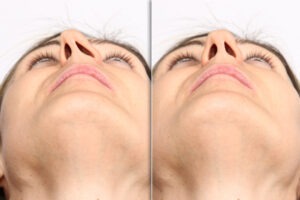The nose has two nostrils that are divided by a partition made of bone and cartilage, known as the septum. This wall doesn’t usually create two perfectly symmetrical nostrils. Instead, it causes a mismatch in size where one nasal airway is bigger. Normally, a deviated septum is no cause for alarm. A deviated septum can be present at birth. Congenital septal deviations are not always progressive, but in rare cases, they can be. A deformed septum can also develop from normal life events, such as car accidents, fights, sports activities, and aging. Deviations that occur early on in life, can become much worse with age or a lack of treatment.
Mild septum deviations are quite normal, up to 80 percent of the population has some type of deviated septum, many of which don’t require medical intervention, according to the American Academy of Otolaryngology-Head and Neck Surgery Foundation. A deviated septum can be present at birth. Congenital septum deviations are not always progressive, but in rare cases, they can be. A severely deformed septum can restrict proper airflow through the nostrils. It can also cause significant discomfort while breathing that compromises one’s overall quality of life. Fortunately, having a deviated septum isn’t a life-or-death sentence. Septoplasty surgery can correct it.
How Does a Deviated Septum Impact Daily Living?
To better understand some of the challenges and potential complications that can arise from having a deviated septum, think about how your nose felt during your most recent cold or sinus infection. Can you recall that aggravating and annoying heaviness or fullness in your nostrils? Maybe you can recall the nosebleeds and irritation you felt while struggling to breathe and exhale through your nose. The challenges or issues you experienced are common concerns for individuals with a mild to seriously deviated septum. The only difference is instead of those symptoms eventually clearing up, the discomfort and struggle to breathe persists and never truly goes away.
A deviated septum can make colds, allergies, sinusitis, and other upper respiratory ailments more difficult to manage. For example, a hallmark sign of many respiratory conditions and irritations is swelling. Swelling in the airways is often due to mucus buildup from infection, poor drainage, and inflammation. When that swelling occurs inside of the nose, the nostrils become even narrower. For individuals with a deviated septum, this can be extremely dangerous.
Usually, those with a slight degree of deviation to their septum have trouble breathing that is manageable with the use of over-the-counter meds, antibiotics, or home remedies. However, individuals with major deviations in their septum often experience more acute distress. Breathing is not just harder; in some cases, it can become downright impossible. Inflammation and swelling from colds and other ailments along with a septum deviation can cause the obstructed side of the nostril to collapse.
Deviated Septum Complications
Breathing doesn’t come easy. A deviated septum causes your nose and respiratory system to work much harder than necessary to allow air to travel through it. Having little to no airflow with an irregular septum reduces the amount of nitric oxide present in the air that travels to the lungs and throughout the respiratory system. Nitric oxide acts as a vasodilator that enhances the lungs oxygen absorption capacity while dilating the blood vessels and decompressing the vascular muscles to give the lungs greater elasticity.
Nose becomes unable to properly filter air. The nose is a primary defense mechanism against germs and pathogens entering the body through the air. Besides adding moisture and warmth to inhaled air, the mucous membrane in the nostrils and airways have antibacterial, antiviral, and antifungal fighting properties. Limited or restricted airways due to a serious deformity in the septum often cause mouth breathing. Smaller nostrils also increase the frequency and severity of sinus infections, colds, etc.
Poor sleep and cognitive performance impact quality of life. A deviated septum makes sleep challenging. Breathing through the mouth requires more effort and causes greater resistance for air traveling through the airways. More force is necessary to guide/push the inhaled air through the appropriate pathways in the nose so it can reach the lungs, leading to noisy breathing and snoring. Major deviations are a common source of sleep disruptions and can lead to diminished cognitive function without treatment. Sleep apnea is another serious concern yet common side effect of septal deviations. Sleep apnea causes periodic pauses in breathing during sleep. Untreated, sleep apnea can lead to high blood pressure, diabetes, sleep deprivation, stroke, obesity, etc. Choking, gasping for air, and an unexplainable ability to fall or stay asleep are the most common signs of sleep apnea and a deviated septum for many.
Sleeping with unrepaired septum wall irregularities can have a negative impact in the bedroom as well. Having a deviated septum doesn’t always just impact the person living with it. Snoring and related sleep disturbances rank highly among bedroom partner complaints.
Nasal dryness and stuffiness that lingers. Irregularities in the septum can cause the nostrils to become uncomfortably dry, increasing the risk of nosebleeds, irritations, and stuffiness. A serious septum deviation can cause pressure buildup in the nasal cavity that spreads to the nose and forehead areas. This sensation is similar to the throbbing head and facial pain that is usually synonymous with sinus infections. Headaches and facial pain stemming from a deviated septum are usually more difficult to manage because they don’t always respond favorably to traditional pain meds, such as ibuprofen, non-steroidal anti-inflammatory drugs (NSAIDs), or acetaminophen.
Deviated Septum Treatment

To learn more about septoplasty or alternative treatments for a deviated septum, contact us to schedule a consultation with Dr. Alen Cohen, our world-renowned board-certified ENT specialist.

